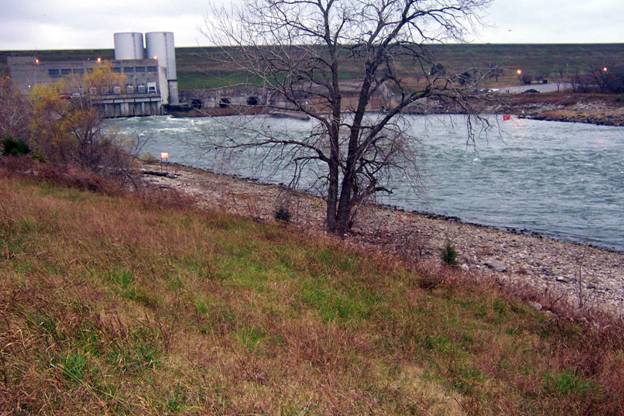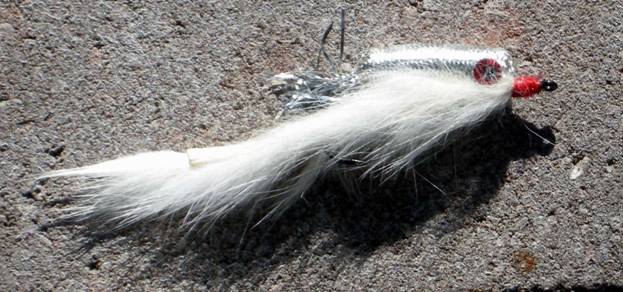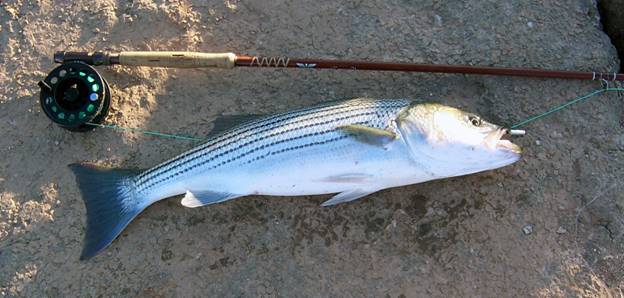RED RIVER STRIPERS
When I was a kid we frequently fished from the levees in the Sacramento and San Juaquin River delta region, mostly hoping to nail a nice striper. The minimum size limit for stripers was 18 inches but it was rare that we ever caught one that big;once in a while, maybe, but not often.
We did catch a whole bunch of smaller stripers, bullheads, squaw fish, carp and the occasional small sturgeon, always on cut bait. The river was silty and peat stained and I could never get a thing on artificials, though I tried vigorously from time to time to do so.
Those fishing jaunts were good memories more for the adventure of the levees than for the fishing. With rods baited and staked before disinterested fish there was naught else to do but explore. We dug clams out of the mud, investigated various beached flotsam, chased down snakes and caught occasional glimpses of muskrat.
So stripers were never really the focal point of those striper fishing memories so much as they were a catalyst to peripheral endeavors. But stripers had potential, as illustrated by a fellow named Larry Green.
Larry Green wrote for the outdoors magazines in those days. He authored several articles about fly fishing for striped bass in the San Francisco Bay area and had photos in those articles of the very large stripers that had always passed nonchalantly by my line on their way up river to spawn. Mr. Green made taking stripers on a fly look pretty interesting and I put the subject into the back of my brain for future access.
That future is now and here in Texas no less. Through the passing of time stripers have been successfully planted in a great number of fresh water impoundments and are now widely available throughout the land. Many reservoirs here in Texas abound with them, as in other states, and the fishing is good.
Lake Texoma is about 90 minutes from my home and is an excellent striper fishery, though with all the largemouth bass fishing available locally I have always been somewhat reluctant to make the drive.
Slowly, slowly I began experiencing increasing insistence from my fishing buddies that the stripers below the dam were worth that drive and great sport on the fly rod, as well.

Dave, the convert, was most persistent in this, annoying me with stories of 2 and 3 pound fish gobbling his and his brother’s Clauser flies and then running amok all over the river, them all the while hootin’ n’ hollarin’ and pretending to be having fun.
That’s very distracting when you’re trying to coax five inch bluegill into biting a #16 black gnat.
So I conceded that it might indeed be fun and I met Dave one afternoon in the parking lot by Dennison Dam. His brother Ron was already down on the river, and by the time we got down the long stairway to the water Ron was onto a fish.

Arching his back against a highly bent and throbbing fly rod, Ron was forced to walk the bank for a while as the fish took full advantage of the current to move line off his reel. But a short while later it gave up and Ron beached a striper roughly 19 or 20 inches long, a strong, sleek and beautiful fish.
I experienced a great deal of anticipatory excitement at that moment. But two hours later that had dwindled to near boredom. I didn’t get a bite. Ron didn’t get another and I didn’t see many others catching them. There were a few other fly fishermen, but many bait fishermen or jig casters had arrived and there was nearly no bank space left. Lines were crossing and my blood pressure was rising.
I wandered down stream a bit, to get below the crowds, found a deep riffle there and got two fish. But they were foot long gizzard shad. I saw them rising and put on a dry fly, which they hit willingly. They jumped like Atlantic salmon and were great fun but, goodness, how they stank! I don’t know what it is about shad, but something in their slime is unpleasant and very persistent. Alas, no matter. The dam shut down, the shad stopped biting, and much later, in lower, calmer water I got an 8 inch white bass. End of trip.
It was quite some time before Dave could talk me into going back there. I vehemently dislike crowds, and the fishing hadn’t justified the drive, but as time smoothed out some of the rough spots and Dave reported a few more successful trips there with his brother I succumbed once again. This time, though, expectations were tempered.
The river was again running strongly from the dam’s release but the crowds weren’t bad because it was early Friday afternoon. Most of the bait fishermen were still at work.

I sauntered down there, starting with my bead headed marabou wonder fly, and fished a few casts. It was quickly apparent that the fly wasn’t going very deep in that current, which I fixed with a bead of split shot. Roughly two casts later I was completely surprised by a strong tug, followed by nothing.
Concentration miraculously restored, I focused on the retrieve like a heron on a minnow. Strip. Pause. Strip. Pause and pow! The strike snapped the line tight so fast that water jumped up all around it and the fish, backed by that racing water, put up quite an initial show of force, stripping about 30 feet of line off my reel in mere seconds. But the water and the fly together began to wear him down and shortly an eighteen inch striper allowed me to edge him into the shallows for the release.
As day progressed into night the fish kept biting and when we stopped my tally was twenty-one, maybe eight of which were eighteen to twenty inches long. The others were somewhat smaller and included a couple of very fat white bass among them.
That trip hooked me, and a couple of weeks later I returned. This time the fish weren’t so active and those old feelings of misgiving began to resurface.
Up river a bit another fly caster was plying his trade so I wandered up for a chat. He was artfully casting a sinking fly line and using about a foot of leader material between it and the fly. More and more it becomes apparent that fishing for stripers isn’t so much a finesse thing an it is an effort just to put dinner in front of their noses and ring the bell.
This fellow told me his personal best striper had been seventeen pounds but that he’d had quite a few in the eight to ten pound range over the years. He stressed the need to get the fly down. Hence, the sinking line. I still had floating line, and my bead headed marabou wonder fly, even with a bead of shot on it, wasn’t getting any interest.
A frantic search of my limited fly box located one fly that might do the trick. Dave’s brother gave it to me on that first trip out and it had sat in the box in silence ever since. It had a body of silver braid, with a rattle inside and a strip of rabbit hide hanging off the back. The fur on the hide was bleached white and there were two pretty eyes painted at the head. It was heavy.

Ron’s rattling rabbit, as I fondly call it now, sank well, but it was a bear to cast, as evidenced by the welt that appeared shortly on the back of my neck. However, within about 5 casts I got the first fish, and I got 3 more in short order, all but forgetting about the whistling whoosh of the fly as it passed by my ear. When thrown well upstream and allowed to drift as draglessly as possible, this fly sank pretty well even in the worst of the flow.
On one cast a fish grabbed the fly on the drift and by the time I noticed anything the current had dragged the line well downstream of it. The weight of the current on the line bent the rod, which clued me in that something had happened. As I picked up the line for the strike it cut a noisy, splashy arc in the fast water and I thought for a moment I had snagged the rocks. But the fish quickly dispelled that notion by running every last bit of fly line off the reel, and some of the backing, before snapping the leader and taking my fly. This has haunted my gray matter for some time.

Now that the summer is over, the lake is lower and the need for electricity to run air conditioners is pretty much done for the season, and the dam isn’t releasing much lately. The water is low, a mere trickle compared to the release, and many who fish here with the fly prefer it that way. The resultant pools and riffles among and below the rocks funnel the fish in a way made to order for hunting with the fly. I like it because it feels almost like trout fishing.

The last time we went up there one could wade completely across, but we found the fishing spotty. Then, as evening set in and the sun dipped behind the dam I got a strike that nearly yanked the rod from my hand. The fish took my line half way to the backing and wouldn’t let me recover it for quite some time. Eventually he came to me, a striper of about 6 or 7 pounds, and until it got totally dark I continued to get action in this pool. I lost a bigger one and nailed 3 others that were smaller. My day’s tally was six stripers, one carp and a tiny small mouthed bass. Dave got two channel catfish on woolly buggers, as well. Variety being the spice of life, the Red River is a pretty spicy meatball. The Denison tailrace definitely runs hot and cold, but if you catch it when it’s hot you’re in for some really great fishing.
Furthermore, there are other opportunities that beg investigation. Bordered mostly by private land on both sides, with little public access, I’m told the river’s banks are fairly pristine, as Texas river banks go, and traveling downstream a fellow could well experience the kind of solitude requisite for rejuvenation of the soul.
Once more, stripers may become the catalyst to adventure, and I imagine that there is a float trip on the horizon involving my kayak, the fly rod, a digital camera and no small amount of Yen.
